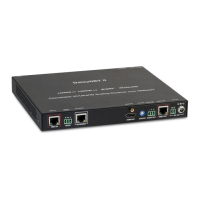Subject to change
COMM-TEC GMBH SIEMENSSTRASSE 14 TEL: +49 7161-3000-0 WWW.COMM-TEC.DE
D-73066 UHINGEN FAX: +49 7161-3000-400
Quick Start Guide
DaisyNET II
1. Assigning an IP address
Each transceiver (TRX) needs a unique IP address. Starting with firmware version 2.6 (ARM), DaisyNET II offers two ways
for configuring the network settings.
a. Manual configuration
o Connect one TRX via Ethernet with your PC. Each TRX needs to be configured separately.
o Enter the default IP address 192.168.1.121 in your browser and login
>>Password: admin
o Menu >> Configuration >> Device >> Network
o Enter a unique IP address, a matching netmask and the gateway address and click „Apply“
o Note: If your device has an unknown IP address, press and hold the „Reset“ button on the front of the device
at least for 5 seconds to execute a factory reset.
o After all TRX units have been configured, they can be cascaded via HDBaseT („HDBT out“ to „HDBT in“).
You can use the bus or ring mode, depending on the application (see manual for further information)
b. Automatic IP configuration (from firmware version 2.6 (ARM) upwards)
Cascade all TRX units via HDBAseT
2. Cabling
- Cascade the transceiver via the HDBaseT bus („HDBT out“ to „HDBT in“)
3. Start “Daisy-chain Sequence”
- Select the first Transceiver in the chain by the WEB GUI
o Menu >> Configuration >> Device >> Network >> Daisy-chain Sequence
o Enter at „DaisyChain Quantity“ the total number of all Transceiver (in this example 4)
o Press „Start Sequence“
4. Ring-type or Chain-type Connection
- If you want to use the Ring-type Connection, close now the HDBaseT bus.
To do this, connect the „HDBT out“ at the last Transceiver with the “HDBT in“ at the first Transceiver

